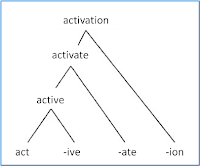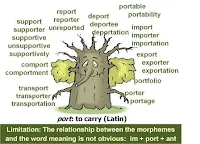 |
| Derivations of Act |
Note: Click images to enlarge them.
Most words are derived via affixation (described below) or compounding. Some words, like brunch and spork, are created by smashing words together in a process called linguistic blending. We also freely create words by morphological conversion, transforming a word to re-use it as a different part of speech, creating a multiple-meaning word. For example, jump, a verb, becomes jump, a noun.
One of the main ways we form complex derivations is through the process of affixation. When we add an inflectional suffix to a base word (-s, -ed, -ing, for example) we do not create a new word, we just create a form of the same word. However, when we add a derivational suffix to a base, we create a new word. For example, the word singer was derived by affixing the derivational suffix -er to the base word sing, transforming a verb into a noun. Thus, the word singer is a derivation. Likewise, the derivation visible was derived by adding the derivational suffix -ible to the Latin root vis, 'to see, look'. Words ending with -ible or -able are typically adjectives, as with predictable, lovable, feasible.
Derivational suffixes have the potential to change the grammatical function of the base to which they are added. For example, evaporate is a verb but when we add the suffix -ion (first dropping the e) we create a noun, the process of evaporation. Most words that end in the suffix -ion (also seen as -tion, -sion, and -ation) are abstract nouns, often involving a process: evaporat
Rule: The final suffix determines the part of speech. For example, graciousness has two derivational suffixes, -ous and -ness. Because it ends with -ness, the word is a noun. Words ending with -ness tend to be abstract nouns, naming a concept or feeling, such as happiness, newness, flatness, peacefulness, harmoniousness, joyfulness. Students who are morphologically aware of this principle will readily realize that the pseudoword scaredness is a noun, indicating 'the state of being afraid' or something along those lines.
Understanding, at least intuitively, how derivational suffixes influence meaning and grammatical function is essential to grasping complex words, prevalent in texts beyond third grade.Shift occurs in derivations, shifts in speaking and spelling (phonological shift and orthographic shift). The word evaporation is a derivation, derived from evaporate, which was presumably derived from vapor. The relationship between evaporate and vapor is not completely transparent because the sounds (phonology) do not overlap completely, even though the meanings overlap. Phonological shift occurs, making it more difficult to "see" that these two words are morphologically related. Because of shifting sounds, many children will not immediately realize that vapor is at the heart of evaporate and evaporation. However, they will more readily recognize vapor in vaporize, because there is no shift in speech or in spelling, and there is some overlapping meaning between vapor and vaporize.
Shift happens often in English derivations. For example, a good deal of shift occurs from persuade to persuasion. Because of shift, it is more difficult for the student to recognize that healthy comes from heal or that pleasure comes from please. The teacher's task is to help the learner discover these hidden relationships, removing the cloak of obscurity.
Semantic shift occurs, also. For example, the meaning of the base word rest does not overlap obviously with the meaning of restive; there is a great deal of semantic shift. Semantic shift also occurs--to a lesser degree--in the transformation from see to seer (see + -er). A seer is not simply 'one who sees' despite the morphological implication; there is an added nuance pertaining to prophecy. Again, consider the semantic shift from secret to secretary. These types of shifting meanings are fodder for rich conversations with students.
Because of semantic shift, some words are not well understood through morphemic analysis. We need look no further than stringent; it means ‘severe, tight, strict’ and has little to do with a string. But we could morphologically link stringent to astringent, one might say. Certainly we could, and likely say, “Now that's a semantic stretch!”
For the average fifth grader, derivations account for the lion's share of known words; vocabulary knowledge grows rapidly after third grade, but only if the student understands--at least subconsciously--how derivations work, including the role of the derivational suffix (Anglin, 1993; Berninger, Abbott, Nagy & Carlisle, 2010). Adolescents who do not understand how derivational suffixes work are not likely to find reading easy; in fact, they are likely to struggle with reading, vocabulary and comprehension (Berninger et al., 2010; Nagy, 2007; Nagy, Berninger, & Abbott, 2006). In that case, we need to provide instruction.
Some Teaching Suggestions:
There are a number of interesting ways to study derivations; some are described elsewhere in Vocabulogic (e.g., The Descriptive Suffix -ish, and The Slippery Suffix -er). One approach is to brainstorm a slew of words with the same suffix and discuss how they are similar. For example, middle school students might work with words ending in the derivational suffix -ism. Students need to realize that words ending with -ism are abstract nouns, as in tribalism, realism, Shintoism, feudalism. The suffix -ism names a practice, belief, philosophy.
The tree graphic illustrates a family of words derived from the Latin root port. Generating morphological families can be interesting, much like solving a puzzle. Deductive thinking allows students to play detective, sleuthing out unforeseen relationships between words. Relationships between phonology, morphology, orthography, syntax and semantics can become more transparent through a morphological family. The teacher's task is to help the child see how sounds, spellings, morphemes, meanings and syntax are coordinated in a word. Students might enjoy discovering or "finding" families of words. A variety of engaging activities serve to promote this type of thinking, including creating root trees, word webs and spoke diagrams, forming a word matrix, building words, inventing words, etc.
A word matrix is helpful, too, along with word sums. Courtesy of Real Spelling and Pascal Mira (© 2010), we can examine a matrix for the family of words that include the base star (click image to enlarge). Read across, attaching affixes to the base, building words. These words overlap to varied degree in phonology (sounds, pronunciation) and orthography (spelling). The shared morpheme star creates overlapping meaning, prompting vocabulary growth. In the star matrix, free morphemes (which are English words) are formatted in bold type and bound morphemes in plain type. With families of words, teachers and students might explore how sounds, spellings, and meanings overlap. Such integrated word study is beneficial, prompting three types of linguistic insight: phonological awareness, orthographic awareness, and morphological awareness (Berninger et al., 2010).
References
- Anglin, J. M. (1993). Vocabulary development: A morphological analysis. Monographs of the Society for Research in Child Development, 58(10)[238], v-165.
- Aronoff, M., & Fudeman, K. (2005). What is morphology? Malden, MA: Blackwell Publishing.
- Berninger, V.W., Abbott, R.D., Nagy, W., & Carlisle, J. (2010).Growth in phonological, orthographic, and morphological awareness in grades 1 to 6. Journal of Psycholinguistic Research, 39, 141–163.
- Nagy, W., Berninger, V., & Abbott, R. (2006). Contributions of morphology beyond phonology to literacy outcomes of upper elementary and middle school students. Journal of Educational Psychology, 98(1), 134-147.
- Nagy, W.E. (2007). Metalinguistic awareness and the vocabulary-comprehension connection. In R.K. Wagner, A.E Muse, & K.R. Tannenbaum (Eds.), Vocabulary acquisition: Implications for reading comprehension (pp. 52-77). New York: Guilford Press.


